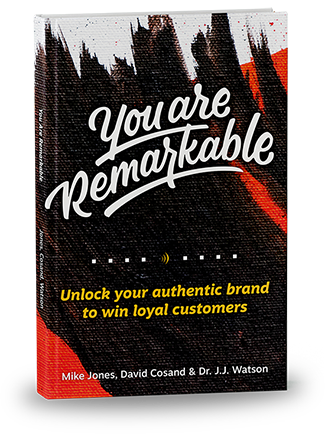Podcast: Play in new window | Download
Subscribe: RSS

How do you measure content strategy? Mike talked about how to think about content strategy, setting the stage for this conversation. So do you want to build trust, or are transactions more important now? Let’s talk about the different ways to measure those two ways of thinking about content strategy.
Can They Trust You? Let Them Know.
People want to trust you. They want to say “yes” to you. But they’re also going to be paying you, so they don’t want a bunch of reservations either. Branding is probably the most important factor in whether people buy from you when reliability or collaboration matters, which makes it huge in B2B. In fact, the more important and consequential the purchase, the more important your brand will be.
Not sure if that’s true? Do a thought experiment: if you’re buying gasoline, you’re not usually as worried about the quality. If your car starts sputtering, maybe you won’t be buying gas from them again. But if you’re hiring someone to paint your house, you want to know if they have references. Are they gonna spill things? Will they leave drips? Will they take my money and leave the job half-done?
And what do you look at to see if you want to work with them? Their reputation, their record of past performance, how they present themselves or how organized they appear…you look at their brand.
So reputation is important, but how do you measure all those things you do that build your reputation? How do you measure the monetary benefit of your values?
Measurement Can Be Tough
Because brand marketing teaches people how to feel about you, it’s hard to detect and hard to attribute. You can’t always tell how someone feels, and even if you could, you can’t always know what made them feel that way. But these people pay full price. They see you as “premium.” They trust you to be organized. They’re likely to be happy with what you’re offering because they already know you and trust that you do what’s right. Because they’re happy, they’ll tell others about you. And it’s hard to measure any of that.
If someone likes you:
- They might tell someone else in a way that you can’t measure, such as a conversation.
- They might decide the next time they want to buy a product that they buy yours, and they may never tell you that.
But they also may do some things that are measurable:
- They may continue to receive your newsletter, even if they don’t get a chance to read it all the time.
- They may open it even if they don’t get a chance to click on any of the links at this particular time.
- And they may read your blog posts because they want to know how to think well.
They want your way of thinking so they can develop their own philosophy around the work that involves your product or service.
Transactional Measurements
It’s easiest if you sell a product or service online. If you sell it directly online, almost everything is measurable. You’re able to measure the entire funnel.
But what about those things that are a little more consulting-heavy. Resound works with a lot of clients who consult, even if they sell a product or a service. Often, they’re big-ticket items that require some explanation or require some interaction, customer-to-salesperson, to provide value beyond just the product or service itself.
This is where you can choose two different paths. Or both. You can choose to go after your existing clients and continue to build those relationships and pull them deeper into your thinking, or you can go after new customers.
Let’s talk about both.
Existing Customers: Building Value
With existing customers, you can and should use a newsletter to teach them how to think. They need to think about your stuff the way you think about it.
If you are a fleet automotive maintenance company, you might have a philosophy about maintenance that encourages people to run it on a 3-month schedule instead of a 4-month schedule. You may even be able to save them money that way. But because it sounds like more work, you may have to explain yourself. You have to share this philosophy and get it out there and show people why it will keep their vehicles running longer or how it will allow them to get more out of the vehicle and then sell it.
Are you an innovator? You may have to convince people. Especially if you’re doing something counter to what the industry is doing or you want to make their really big deal about a small difference you make that makes a difference for people.
Build an email newsletter.
- So you can create a newsletter list that nurtures leads (keeps them interested and gives them new information and new ways to think about things, along with opportunities to engage with you). You create a list of people who are more engaged and you give them more offers because they have shown that they’re more interested in what you have to sell.
- You give them opportunities and excuses to buy based on events that happen in the economy, holidays, or times that are special for you that they would understand, or times that are special for them.
- You engage their thinking and in a direction that’s going to help them to buy.
The More Money a Sale is Worth, the More You Need a Content Strategy
The bigger the customer investment and the longer the sales cycle, the more value a content strategy offers you.
What Media are in a Content Strategy?
The basics of a content strategy are email (Campaign Monitor, Mailchimp, etc.), a blog and social media.
- Why email? This is your marketing channel that reaches into people’s inboxes. You can see every interaction you have with them and you can see who did it.
- Why a blog? Because, like email, it belongs to you. Facebook, Youtube, and Twitter can disappear or decide they don’t like you and take away your blog. A blog is your real estate.
- Why social? Because although you don’t own the media channel, you can still reach people who haven’t heard of you. You might as well share.
Remember, this content strategy is your content strategy. It’s your list. It’s your medium. It’s a little bit like having a magazine that you create for only your customers. You own all their information, you decide where the ads go; it’s yours. You can add any kind of production value you want to make it engaging and interesting and something they want to open and read.
Getting Conversions from Nonexistent Customers
So how do you get from someone who doesn’t know about you to someone who’s buying from you? Here’s a little refresher: to get people who aren’t already your customers to sign up to buy your stuff, it’s a process. There’s this pyramid that many marketers become familiar with that outlines conversions.
- You generate awareness, which gets them to know about what makes you different and start to understand how it might fit their lives.
- You move to interest, which is when they decide that it might be something that might matter and help them.
- You move then to desire, where they realize they want it.
- And then to action; where desire meets opportunity.
Email supports this because it allows you to track people through the funnel and know who’s who. Google Analytics tells us how many. But it doesn’t tell you who went through and got to the bottom of the funnel. since you on this media channel, you are the one who is able to figure this out from the data. In fact, almost all platforms allow you to give this data.
Build Your Subscriber List
To build your list, most people…
- Advertise; tell people about what you have going on via social media.
- Once they follow the link to the landing page you offer them what’s called the “lead magnet,” something for free, to help them make the decision to sign up for your mailing list.
- Once they’re on your mailing list, you put them on a welcome journey which is a series of emails that guide them through a compelling case that, if possible, brings them to the point of buying.
- If they don’t buy through that journey, you simply add them to your regular list.
And all this is automated.
If they don’t bite on the email list, continue to give them opportunities to learn in a rich, email environment, ways to think about the job they’re trying to get done, resources that will help them, and then an opportunity to buy from you.
So now you can see the funnel.
- They start out visiting your lander. So try to improve the percentage of lander visitors that sign up for your email list.
- They sign up for the email and get the lead magnet.
- They go into a welcome funnel that gives them an opportunity to buy. So try to increase the percentage of people who buy during that journey.
- They go into your regular funnel if they don’t buy (heck, and even if they do buy). So try to engage them with good content that improves their open rate (how many open the email) and click-through rate (how many follow links).
The Goal: Straighten the Funnel
So now what you’re trying to do is straighten the funnel. If you can you wanted to look as much like a silo as you can. You want the bottom of that funnel to spread out so that it matches the top. But this is hardly ever going to happen, and that’s okay. The point is that you’re measuring the percentage of conversions so the next level down the funnel and then doing everything you can to increase those movements down the funnel in a way that reinforces the reason people like you.
In other words, bring them down the funnel in a way that builds on the reason people like you and trust you. It’s not complicated, and there are tons of tools that will help you to do this. But usually, it involves finding the right people and delivering the right message at the right time. And how will you know that until you do it? So what are you waiting for? Start building your funnel today.
Speaking of funnels, if you’ve found this content to be helpful consider subscribing to our newsletter. We’ll send you even more great content like this right to your inbox every month. It’s all our brand wisdom from the month located in one convenient location.



